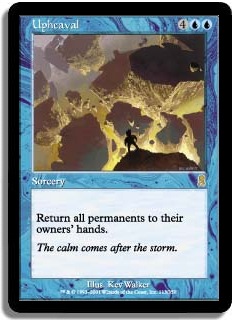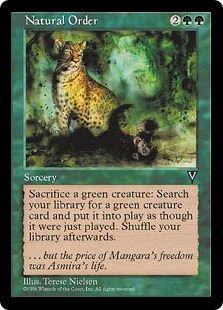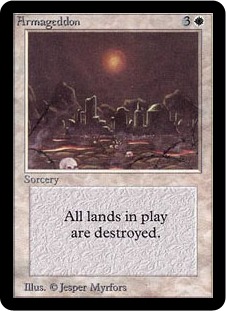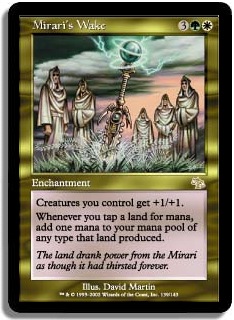Once upon a time 100 Card Singleton fans battled every weekend for fame and glory in the now forgotten Weekend Challenges. But since the replacement of these by Daily Events and eventually the cessation of even those, players who wanted to play 100 Card Singleton could only do so in the casual room or in the 2-man queues. Fortunately, that is about to change with the new PRE (Player-Run Event) Vivat centum!, and it is going to reborn from its own ashes Phoenix-style. Check here for full details.
In this new journey, MTGO Academy wants to guide you through the near-limitless options 100CS offers and make it easier for you to build and play. We will be examining — like a surgeon — all kinds of competitive decks, and maybe sprinkle in some ideas so you can afterward get down and dirty building your own decks.
So let me introduce myself: I am slug360, and I have been playing Magic since old Mirrodin and 100 Card Singleton, my favorite format, were available on Magic Online.
What I have here for you today is probably one of the most common and customizable color combinations in 100 Card Singleton: blue, green, and white (aka Bant). We will examine three different Bant builds to showcase the color combination’s power and versatility.
Naturally Bant
Natural Order Bant, by slug360
This list offers the following:
- Some acceleration in the form of green creatures to help cast Natural Order
- Cheap, efficient, and versatile creatures such as Scavenging Ooze and Qasali Pridemage
- Countermagic, removal (worth noting is the addition of Detention Sphere to deal with planeswalkers or annoying permanents and for recursion with Sun Titan)
- Upheaval, one of the most game-changing spells available. (It will give you lot of wins out of nowhere.)
The plan is to cast your spells while trying to control your opponent’s biggest threats, either by countering them or removing them from the battlefield. To achieve this you have to play differently against different archetypes.
Against aggro decks (Goblins, Zoo, and Elves mainly), you want to avoid their early offense at any cost since, if you manage to reach the late game, your bigger and stronger threats will probably take control of the game. This means, for example, trading your Lotus Cobra for their Goblin Guide or a similar threat. You should also be careful with your manabase, since these decks usually play non-basic hate such as Dwarven Miner or mass land destruction in the form of Armageddon. Therefore, try to search for basic lands if possible, hold onto extra lands, and use your countermagic for the spells that really matter. You just need 6 mana available to cast all your spells except Progenitus, which you don’t plan to hardcast anyway.
Against control decks (UW, UWB or Grixis) you usually don’t care about their countermagic. You want to make use of all your mana and prevent them from playing their spells during your end step. Also try to cast your spells in such a way that you cast more than one spell per turn. This way your opponent will have a harder time dealing with all your spells. Don’t overcommit! These decks run mass destruction spells like Wrath of God and Oblivion Stone. Let them tap out to deal with your stuff, and afterwards play your other cards.
Try saving your countermagic to defend key spells you want to resolve or to deal with their game-changing spells.
The sideboard is suited to try and deal with these two archetypes (aggro and control). Besides the obvious choices, we have heavy hitters in Linvala, Keeper of Silence, who shuts down most Goblins and Elves, and Bribery, useful against most control builds.
The Armageddon
ArmaBant, by slug360
|
| ||||||||
This deck is an update of a deck from 100 Card Singleton guru and source of inspiration for many of us, Travis R. Chance (aka so_many_trolls, aka book).
I suggest checking his decktech and card-by-card analysis of this deck available at this link. You can also search the archives of MTGO Academy for many other 100 Card Singleton decktechs and more.
The core of his deck remains intact. I just added green only for Knight of the Reliquary and Tarmogoyf, since adding Terravore seems a bit greedy, and updated the deck with newer cards such as Terminus and Detention Sphere. Bribery makes the maindeck since here we don’t have Natural Order or Upheaval to search for with Mystical Tutor, and it offers something different from our other possible Mystical Tutor targets. As an aside on tutors (but an important lesson nonetheless), when you play various tutors you should try to include cards that can be searched for with as many of them as possible; for example, Wurmcoil Engine can be tutored for with Enlightened Tutor or Eladamris Call, or creatures with flash like Venser, Shaper Savant can be searched out with Eladamris Call or Mystical Teachings. Also try to play sideboard cards that can be tutored with your maindeck tutors, such as Sphere of Law and which can be used against different strategies, such as Luminarch Ascension.
ArmaBant is all about synergy, and it can take bit longer to learn to play it correctly, but the normal line of play is to cast Armageddon at a point to leave you in control of the game. The good thing about this deck is that your game plan is pretty much the same against aggro or control. Counter, destroy, bounce, or exile anything your opponent plays, and then blow up the world with Armageddon. Afterwards you should be in a much better position than your opponent to recover from it and seal the game.
This build in particular is versatile since it can behave also as a UW Control deck given its large quantity of countermagic. So don’t be afraid to play it like a control list; just never forget your primary goal is to ‘Geddon.
Old School
Mirari's Wake Control, by slug360
|
| ||||||||
In the above list, what I tried to do is to translate to 100 Card Singleton the deck Daniel Zink piloted to first place at the 2003 Magic World Championship. You can find the full coverage of the event here.
This is probably the deck I enjoy the most. It has answers for anything, it can do everything, and it does it in a big way. Once you land Miraris Wake or Mana Reflection, you turn into an unstoppable train that chains card draw into countermagic into bomb into right click->concede game). Seriously, it is the closest you’ll be to feeling like Son Goku in Super Saiyan form. (If you don’t know what I am talking about, think about being Shaquille O’Neal and playing with baskets made out of plastic.)
The game plan is to play some ramp spells like Cultivate or Oracle of Mul Daya, and to generate card advantage by drawing cards with Fact or Fiction, Future Sight, etc., and clearing the board with Supreme Verdict, Austere Command, etc., until your opponent is out of resources and you can destroy him with four 4/4 flying angels from Entreat the Angels.
Against most aggro decks you are going to suffer at the beginning, but once you stabilize and the games go long, the chances to lose decrease. Besides the spells, lands like Kor Haven and Maze of Ith have an important role in the deck’s plan.
Your life is a resource you have to manage carefully. Deciding when to play your mass removal spells like Rout is key. You have to think whether the damage they are going to deal to you is worth that possible extra card they could commit. To figure this out, check how many cards your opponent is holding, your life total, the other castable cards you have, the board state, and both graveyards and what will be in them after you clear the board. Seems pretty basic, but sometimes you miss something that can be fatal.
The control matchup is all about hitting your land drops. The more lands, the more spells you can play and counter. You should always try to play your land each turn, at least until the mid-game, especially in this build. Avoid tapping out, and again, use your countermagic to protect your spells against their countermagic or to counter their key spells. Don’t waste them on their card draw spells unless they are short on cards, but this depends on the game state of course.
Some Bant Side Notes
- I typically try to play two or three spells maindeck against aggro and control, but ones that are not dead card against any deck. Spells like Decree of Justice, for example, shine against control, since they can’t do anything about its cycling ability, but it can also ambush an aggro deck, replace itself, or act as a Fog.
- These builds should be taken as guidelines since many cards appear based only on my personal preferences, and I am sure I missed many playable cards. Feel free to post your suggestions in the comments below, and also let us know what decks you want to get examined, what you liked or not, or whatever you think will improve these articles.
The Bant Core
For informational purposes (to help you start a Bant list), here are the cards which appeared in all three main decks. These are the cards that I tend to think should be in any serious Bant list that has a game plan remotely similar to any of the above.
Bant list intersection, by slug360
|
| ||||||||
Conclusion
As you see, all three decks have cards in common, but also each doesn’t play all the typical cards you would expect to see if you play these colors, such as Oblivion Ring in the Miraris Wake Control deck. (In that case, you don’t want to play it because the deck runs cards like Oblivion Stone and Austere Command.) My point here is that it is very difficult to build a 100 Card Singleton deck since you have to keep in mind a lot of things and a lot of cards, but that is what makes this format so exciting and challenging to me. In fact, I think this is the format where there is room for any idea as long as you are prepared to face any deck and focus on your deck’s game plan and goals. There is no perfect deck in 100 Card Singleton.







The shards seem like a decent starting point for 100CS if you haven’t played it before.
Check out:
http://www.mtgpulse.com/events-highlander for more inspirations for decks taken from a similar game type (Highlander, European Style)
Good call phobos, definetly going to bookmark it.
Just remember that they use a different ban list from 100 Card Singleton.
Thats true Slug, BUT they have a lot of similarities in the banned list! I think, judged from the current metagame, there are no huge differences (Besides Demonic Tutor, Lftl, Intuition, Sensei Top etc. -> that turned out to be “OK” in the current creature/curve- heavy meta). Due to the fact, that you’re allowed to play Birthing Pod (BP got banned from the format in europe, cause it created such a huge CA) :-), this brings me to the conclusion that you have to test out a “Pattern Rector”- mechanic based deck! It’s awesome.
Regards from Germany
Very interesting and didactic article, good job mate, i hope you can show more of your knowledge in more articles.
Congrats slug.!!!!!!
I have awakened!
So, listen, as I have a few things to say, after adjusting my crown of sparrows:
1.) Bant is never an easy build; there’s a ton of great cards… which is the prob. You can lose focus. Kool and I worked on Bant religiously, and none of the builds were ever as good as Naya–esp. in the ‘geddon dept. You try to play spot removal, counters, awesome guys… your deck will always be over, and, if you cannot balance it accordingly, it will not be as good as cutting white and just playing U/G 9 times out of 10.
2.) If you are playing green, and you play ‘geddon, not playing Terravore is silliness. That card, hands down, equates a brutal death when played correctly. In a format where most people play as many fetch lands as possible, and you can reinforce this with your own ‘geddon-like spells (see: Ruination), this guy craps down Progenitus’ many throats.
3.) Kudos on this article and trying to bring back this format, which was ruined in the hands of its creators. I finally am ill at the thought of playing Commander. Maybe I will come win this thing and be mean to most of you, while shaking my head at your deck choices.
BTW: my comment is for those who will, inevitably, start tweaking themselves into a pile of nonsense, not yours, dearest OP.
I am glad you have waken up Travis ready to battle.
From personal experience U/G is kind of vulnerable to Goblins and RDW, and Zoo isn’t an easy matchup either (at least a version of U/G deck I played based around Winter Orb and Oppostion). I think Bant has a better matchup against these deck.
About Terravore you might be right, I just didn’t want to change much your deck (hope you didn’t shake your head too many times while looking at it). Maybe I focused too much on the double green tax.
Looking forward to fight old 100 Card Singleton buddies, it is going to be awesome.
Hey hey!
So I played in some 2-mans last night, and was up 2-1 with some weird Doran deck I built, which I think I shall be thusly tearing down in the coming days; Junk is just too weird of a deck to play in this format, me thinks.
In terms of Terravore, it’s easier, with all the fetches and duals, to hit a third color than often hitting a second. This may not be true of hitting a double cost in a splash color, but, oh the mama (I meant that, “the mama”), can you really bash someone’s face in if you have the countermagic to back this one up.
I’s been so long since I have even considered this/had Commander on the brain that I am slowly remembering what is good/available in this format. Kudos on the artikool.
Really happy to see some articles about this format. I was getting sick of playing 1v1 commander and trying to have fun, but not being able to since you’re forced to play all the broken crud if you hope to win a few.
100 CS has a much better banned list.